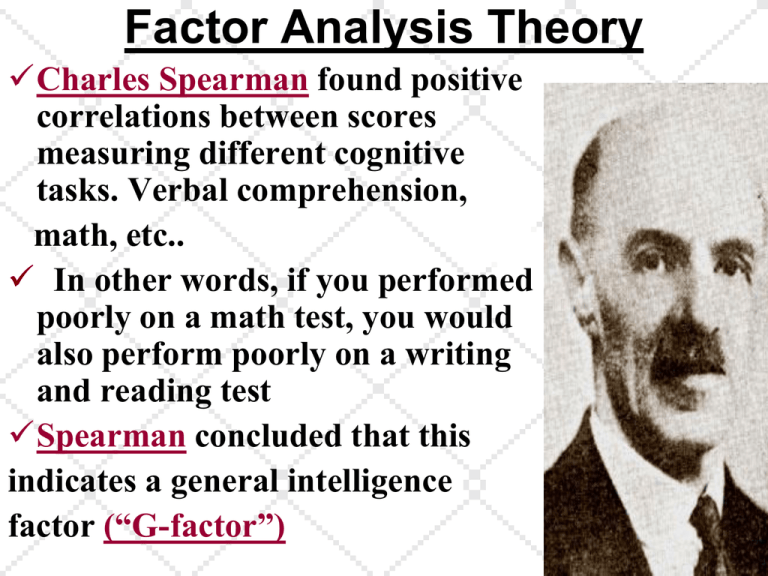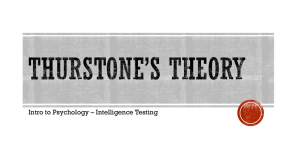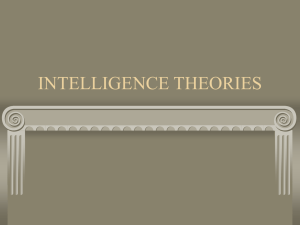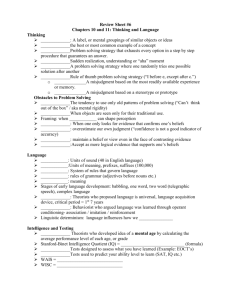INTELLIGENCE Howard Gardner (director of Project Zero at Harvard
advertisement

Factor Analysis Theory Charles Spearman found positive correlations between scores measuring different cognitive tasks. Verbal comprehension, math, etc.. In other words, if you performed poorly on a math test, you would also perform poorly on a writing and reading test Spearman concluded that this indicates a general intelligence factor (“G-factor”) Louis Thurstone • Like Spearman, Thurstone used factor analysis to test his subjects • Unlike Spearman, he concluded that there was no general intelligence or G-Factor • It was possible to possess different cognitive strengths & weaknesses. • Primary Mental Abilities: word fluency, verbal comp., numerical calc., associative memory Robert Sternberg • Psych. Faculty at Yale University • Creator of Triarchic Theory • Former APA President (2003) "I define [intelligence] as your skill in achieving whatever it is you want to attain in your life within your sociocultural context by capitalizing on your strengths and compensating for, or correcting, your weaknesses.” (July 29, 2004) The Triarchic Theory I. Componential or Analytical Intelligence: verbal reasoning • Choose one word which means either the same as, or the opposite of, the word in CAPS: SOILED a)GARDEN b)CLEAN c)PLANT d)WALK TRIARCHIC THEORY II. Experiential or Creative Intelligence: ability to solve problems in insightful ways (creativity or divergent thinking ability) Triarchic Theory (cont.) III. Contextual or Practical Intelligence: function in social situations (street smarts) INTELLIGENCE Howard Gardner (director of Project Zero at Harvard University) Multiple Intelligence Theory • Proposed by Howard Gardner (Harvard University) in 1983 • Like Thurstone and Sternberg, Gardner rejected the notion of a “G-factor” involving intelligence • Believed intelligences to be brain based through hemisphere dominance and neural connections which determine our strengths and weaknesses Left Brain • Math • Reading • Writing Verbal Comprehension Right Brain • • • • Visual Arts Spatial Skills Creativity Emotional Intelligence Multiple Intelligences • Verbal / Linguistic: think in words & language • Logical / Mathematical: analyze arguments and problem solve • Visual / Spatial: arranging objects and/or pictures • Musical: thinking in sounds or rhythms (lyrics) • Kinesthetic: thinking through touch or movement manipulation • Interpersonal: social skills and group strengths • Intrapersonal: knowing well and exploring one’s own thoughts and feelings and motivations Emotional Intelligence (EQ) • Proposed by Dr. Daniel Goleman, an American psychologist, in 1995 • Concerns the ability to manage one’s emotions • Determines one’s ability to socialize, get along with others, and maintain psychological health. Emotional Intelligence (EQ) • Dr. Goleman’s EQ is closely tied in with Howard Gardner’s Intrapersonal & Interpersonal Intelligences as well as Dr. Sternberg’s Contextual Intelligence Level within his Triarchic Intelligence Theory. • High Emotional EQ is often associated with people who are great leaders and who are able to work well with diverse groups of people at all levels. • Problem solvers, not complainers. Learning & Intelligence Quiz 1. A 2. A 3. A 4. C 5. D 6. C 7. A 8. D 9. B 10. B 11. B 12. D 13. B 14. A 15. D 16. C 17. B 18. D 19. D 20. A 21. A 22. D 23. A 24. A or D 25. D




